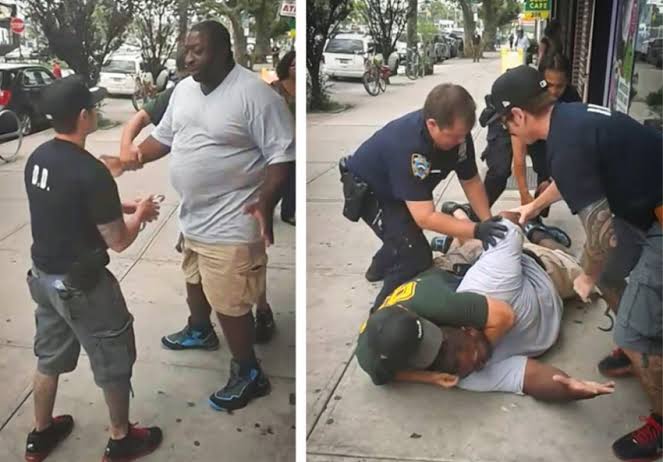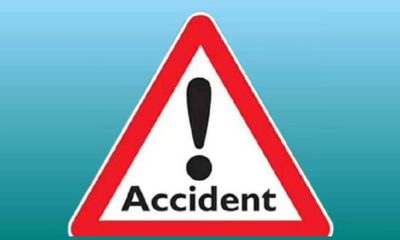Crime
US trains cops to kill blacks with ‘Prone Restraint’ technique
Published
4 years agoon
By
Olu Emmanuel
It is what it is.
America is also a terrible place.
We can’t keep quiet and allow these things continue.
You can’t murder a man for forgery!
White cops kill blacks.
That’s what it is.
Good cops don’t testify or speak against bad cops. So it makes all of them terrible as well.
And the way that police man killed the black man isn’t new.
They are trained to kill that way.
It has a name.
A technique which is sighted as a factor in so called ‘deaths in custody’ is what is known as ‘prone restraint’.
It involves forcing a suspect face-down onto the floor, cuffing their hands behind their back and then putting pressure on their torso, shoulders and neck.
Sadly this is allowed.
A 2010 report by the Independent Police Complaints Commission (IPCC) into deaths in police custody states that between 1998 and 2009 there were 16 cases in which restraint was a direct or contributory factor to the death.
But research by the Bureau and the charity Inquest has identified a further eight cases where restraint was an issue – a figure 50% higher than the IPCC’s number.
Terrible that an officer would pin the suspect’s body to the floor with a knee on their back, and another would immobilise the suspect’s head by kneeling on their neck.
In the same country, Prison service rules now state that ‘a prisoner must never [original emphasis] be kept in the prone position with their hands held behind their back in ratchet handcuffs’.
But is it obeyed?
The guidelines add: ‘Pressure should not be placed on the neck, especially around the angle of the jaw or windpipe. Pressure on the neck, particularly in the region below the angle of the jaw (carotid sinus) can disturb the nervous controls to the heart and lead to a sudden slowing or even stoppage of the heart’.
Dr John Parkes, a restraint expert at Coventry University, points to the fact that from 1991 to 1995, before the rules were changed, there were five restraint-related deaths in prisons. He says this is clear evidence that the way restraint techniques are practised affects the frequency with which they lead to death.
Police training does raise awareness of the dangers of prone restraint, but it is less strictly worded than prison officer training. A 2004 Metropolitan Police review recommended learning from the approach of the prison service.
The review stated: ‘Lessons can be learned from the Prison Service where team leaders are employed to direct restraint teams. The role of the supervisor is to take immediate charge of the incident, monitor the health of the person being restrained and actively control the restraints being applied’.
Practical experience:
Dr John Parkes, the restraint expert at Coventry University offered to put an interviewer in the forced prone restraint position to get a personal perspective of what it was like. He told the reporter to get face down on the floor, locked his arms behind him as if they were in handcuffs, and then knelt on his back.
Reporter was lying on a soft mat in a carpeted classroom. Even with only one medium-sized man kneeling on his back it was immediately extremely difficult to breathe. In many of the cases examined by the Bureau more than one officer – and often several – knelt or put their weight on the suspect.
In many of the cases the suspect also pinned down onto concrete. Officers also kneel not just on a suspect’s back but often on their necks as well. In many cases the suspect would have been panicking and exhausted.
Dr Parkes kept his weight on the reporter and he felt trapped and completely unable to catch his breath.
But Deborah Coles, director of Inquest, a charity that takes on cases involving deaths in custody, believes there are ‘fundamental problems’ in the effectiveness of police training in restraint.
“If someone puts you in a position where you can’t breathe, you’re going to struggle to get out of that position.”
Referring to guidelines she said: ‘My fear is, and I do put this in the context of cuts to frontline services, that there is the ever-present risk of death and serious injury and that this is an issue that does require proper public and parliamentary attention as a matter of urgency.’
Dr Parkes recently completed a Youth Justice Board-funded study on the dangers associated with sitting restraint techniques – thought to be some of the least dangerous restraint methods.
He said: ‘In the cases in our research, we have used no extreme force, but in some cases have restricted their ability to breathe by up to 80%… That was done with very, very little force indeed.’
‘If someone puts you in a position where you can’t breathe, you’re going to struggle to get out of that position. One of the things that’s going to happen is the people restraining are going to perceive that as a renewed attempt to escape’, leading them to apply even more force.
‘In fact, if you were able to question the person, they would tell you ‘I wasn’t trying to escape, I just couldn’t breathe’.’
Terrible.
This piece was done with help from a 2012 report from The Bureau Of Investigation. Meaning this is not new. And the white bad cops no they can always get away with it. It also means the technique used on George was deliberate. They decided to take his dead body from the point they asked him to go down. Slowly. Painful. Death.
Trending

 Football2 days ago
Football2 days agoGuardiola advised to take further action against De Bruyne and Haaland after both players ‘abandoned’ crucial game

 Business1 week ago
Business1 week agoDollar crashes further against Naira at parallel market

 Business1 week ago
Business1 week agoRecapitalisation: Zenith Bank to raise funds in international capital market

 Education1 week ago
Education1 week agoArmy reveals date for COAS 2024 first quarter conference

 Crime1 week ago
Crime1 week agoFleeing driver injures two on Lagos-Badagry expressway

 Covid-191 week ago
Covid-191 week agoBritish legislator demands Bill Gates, other ‘COVID Cabal’ faces death penalty

 Latest6 days ago
Latest6 days agoIsrael pounds Hezbollah with airstrikes after Iran attack

 Business1 week ago
Business1 week agoZenith Bank surpasses N2trn earnings milestone

